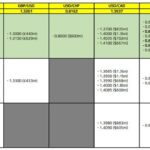
Decoding FX Option Expiries: Navigating Market Sentiment Ahead of April 2025
Tháng 4 16, 2025US Import Prices and NY Fed Manufacturing Index Drive USD Volatility
Tháng 4 16, 2025U.S. Dollar Under Pressure: Factors Influencing its Decline
The U.S. dollar, once regarded as a bastion of stability in global finance, is currently facing mounting pressures, evidenced by its weakening value against major currencies. Analyzing the various factors at play unveils a complex picture that not only affects the dollar but also has far-reaching implications for the global economy.
Impact of Tariff Policies
Recent tariff announcements have introduced significant volatility into the financial landscape, creating a ripple effect that has led to a decline in the dollar’s value. As tariffs were imposed on certain U.S. imports, investor confidence began to wane, with market participants reacting by pulling back from U.S. assets. Although a temporary 90-day pause on some tariffs provided a brief respite, it failed to restore overall market stability. Consequently, this climate of uncertainty has caused many investors to reassess the safety and reliability of the dollar as a store of value, raising concerns about its long-term viability in the face of shifting trade dynamics. As noted in a recent analysis, these tariff dynamics are pertinent in understanding the current value of the U.S. dollar amidst global shifts (source).
A Crisis of Confidence
The intertwined fate of the U.S. dollar and Treasury bonds serves as a critical indicator of market sentiment. Experts, including former Treasury Secretary Janet Yellen, have voiced apprehension over what might be interpreted as a crisis of confidence in U.S. assets. Traditionally, during periods of economic turmoil, the dollar and U.S. Treasuries would see increased demand, reinforcing their status as safe-haven assets. The current scenario, however, depicts a worrying trend: as both the dollar and Treasury bonds experience declines, questions arise regarding the reliability of these investment vehicles that play pivotal roles in global financial stability.
Mixed Market Performance
Global stock markets have exhibited a mixed performance in recent months, with some sectors managing to rally on the prospect of potential tariff exemptions. Despite these temporary boosts, the overall year-to-date performance has been marked by losses in various indices. Analysts have begun to scrutinize the dollar’s status as a reserve currency, drawing comparisons to emerging markets plagued by policy unpredictability. Such assessments highlight a critical shift in perception—where once the dollar was synonymous with strength and reliability, it now faces scrutiny, risking its standing in international trade and finance. As discussed in related forex analysis on the EUR/USD currency pair, consolidation patterns may provide insights into shifts in sentiment toward the dollar (source).
Complications from Trade Dynamics
As ongoing trade tensions continue to simmer, the outlook for the dollar becomes more precarious. There is growing talk of countries such as China potentially reducing their holdings of U.S. Treasuries, which could further exacerbate volatility in both currency and bond markets. Such moves could result in a feedback loop that diminishes demand for U.S. assets and raises domestic borrowing costs, ultimately undermining economic confidence.
In conclusion, numerous factors contribute to the current pressures facing the U.S. dollar, from tariff policies to a broader crisis of confidence among investors. As the global economic landscape evolves, stakeholders must closely monitor these dynamics, keeping a watchful eye on how they will shape the future of the dollar and its role in international markets. As insights into the dollar’s trajectory become clearer, understanding these influences will be essential for navigating the complexities of the financial world.
